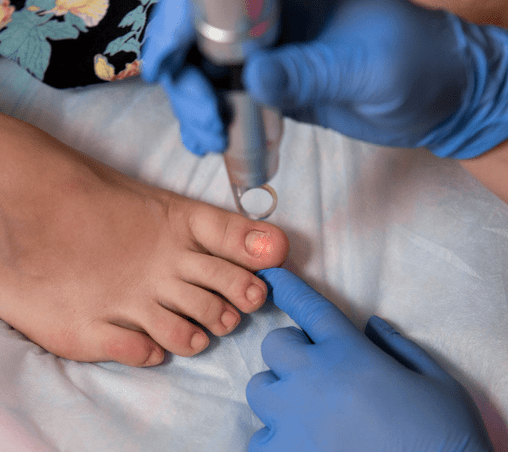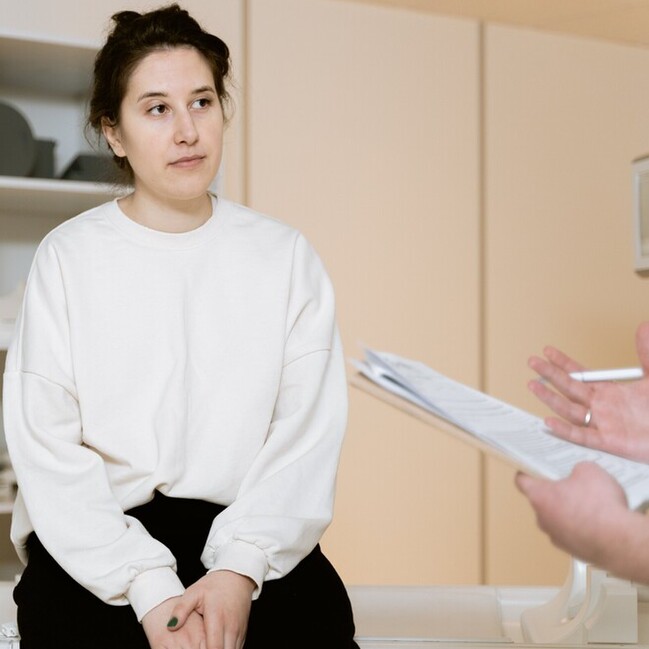Surgery
For severe or recurrent fungal nail infections, surgical treatment may be recommended to remove infected nail tissue and restore a healthier foundation for regrowth. At Foot Foundation, our podiatrists perform precise, minimally invasive procedures under local anaesthetic to ensure comfort, safety, and improved treatment outcomes.
What do I need to know if I’ve been recommended to undergo surgery?
Surgical procedures are deemed minor and are performed in our clinical rooms at Angelsea Clinic. Only the part of nail that is diseased will be removed.
All three procedures are performed under local anaesthetic to prevent pain during the procedure. The clinician undertaking the procedure will loosen the skin surrounding the nail and separate the nail from the nail bed using specialist equipment.
You may wish to prevent the nail from growing back to guarantee the fungal infection is not able to reinfect the area. We can do this by destroying the nail matrix with a chemical called phenol which is applied to the cuticle after the affected nail has been removed.
Alternatively, you can allow the nail to re-grow. In this instance, we recommend a combination of fungal treatment to reduce any re-infection of the new nail. This approach is not guaranteed.
Following your procedure, the treated toe will be heavily bandaged and regular dressing changes will be required for two weeks until the wound site has healed. Your clinician will monitor your wound site closely over the following four weeks.
Who performs this procedure?
At Foot Foundation, our qualified podiatrist will perform nail surgery of the toenails.
If fingernail removal is required (which is much less likely), you will be referred to your GP or a specialist to have this procedure performed.


What are the risks involved?
Your clinician will outline in depth the risks involved with this procedure. However, the three main risks involved with this procedure are:
Pain
Infection – you can reduce the risk of infection by keeping the surgical site clean
Abnormal nail growth – when the nail grows back, it may grow back in an odd or thickened shape
How do I get diagnosed?
Your diagnosis takes place during a consultation with our Foot Foundation clinician. They will take a thorough medical history, consider your risk factors, complete a comprehensive physical examination and use a Diafactory fungal nail test to correctly diagnose your fungal infection.
Diafactory fungal nail tests involve taking a clipping of your toenail, taking photos of your infected nails and measuring the line of fungal growth from the base of the nail so we can monitor your treatment over time.
Once a correct diagnosis has been made, your Foot Foundation clinician will discuss the most appropriate treatment protocol with you and answer any questions that you may have.

What is involved in the surgical treatment process?
If surgery is the right option for you, your podiatrist will take a comprehensive medical history to mitigate any potential risks involved with nail surgery.
The procedure will take place in Anglesea Clinic by a trained podiatrist. The procedure typically takes 60 - 90 minutes, depending on how many surgical sites are involved.
After your procedure, you will be given a surgical dressing pack with comprehensive instructions on how to look after your wound.
You will be required to see your podiatrist for the first two dressing changes. The podiatrist will examine the wound and provide clear instructions on aftercare until the wound is health.
Once your wound is healed, you will commence your recommended combination treatment and receive important information about appropriate hygiene and prevention protocols to reduce your re-infection rates during and after treatment. We are happy to answer any questions you may have.
Surgery – FAQs
Surgery is usually considered when fungal nail infections are severe, recurrent, or unresponsive to other treatments such as topical or laser therapy. It may also be advised when the infection causes significant pain, discomfort, or nail deformity. At Foot Foundation, we assess each case carefully before recommending surgery.
Foot Foundation offers three surgical options, depending on the extent of infection:
- Total Nail Avulsion – removal of the entire nail.
- Partial Nail Avulsion – removal of one side of the nail.
- Debridement – removal of only the diseased portion of the nail.
Your clinician will determine the most suitable procedure based on the severity and location of the infection.
All nail surgeries at Foot Foundation are performed by qualified podiatrists in our clinical rooms at Anglesea Clinic. If fingernail removal is required (which is uncommon), you’ll be referred to your GP or a specialist for the procedure.
The procedure is considered minor and is performed under local anaesthetic to ensure comfort. Your clinician will:
- Numb the toe completely.
- Gently loosen the skin and separate the affected nail using sterile equipment.
- Remove the diseased portion of the nail.
- Optionally apply phenol to prevent regrowth (reduces re-infection risk). If you choose to allow regrowth, surgery is combined with antifungal treatments to minimise recurrence.
The procedure typically lasts 60–90 minutes, depending on how many nails or sides are involved. You’ll be able to go home shortly after, with your toe properly dressed and post-operative care instructions provided.
Your toe will be heavily bandaged immediately after the procedure. Regular dressing changes will be required for about two weeks until healing occurs. Your clinician will review your progress and monitor the wound closely during the first four weeks to ensure optimal recovery.
Surgical treatment for fungal nails is very safe when performed by trained clinicians. Potential risks include:
- Pain or discomfort during healing
- Infection (minimised with proper wound care)
- Abnormal regrowth (thickened or uneven nail)
Your clinician will discuss these risks and how to minimise them.
Yes. Combining surgery with topical, oral, or laser antifungal therapy significantly improves success rates by clearing remaining fungus and preventing re-infection as the nail heals.
Before the procedure, your clinician will review your medical history to identify any risks and ensure surgery is safe for you. You’ll receive clear pre- and post-procedure instructions, including wound care and hygiene advice.
Diagnosis is made during your consultation at Foot Foundation and includes:
- Detailed medical history and risk factor review
- Physical nail examination
- Diafactory fungal nail test — nail clippings, photos, and measurements of fungal growth
Based on your diagnosis, your clinician will discuss the best treatment plan and whether surgery is appropriate.
Surgical procedures are performed by Foot Foundation’s podiatrists at Anglesea Clinic and are available by referral from any of our clinics: Pinehill, Smales Farm, Remuera, Botany, Hamilton, and Tauranga.
Book Your Surgery Appointment Today
Our clinicians perform minor nail surgery procedures—including total nail avulsion, partial nail avulsion, or debridement—depending on the severity and location of infection. These are carried out in-clinic under local anaesthetic to ensure a comfortable experience.
During the procedure, only the affected nail portion is removed, and patients can choose whether to prevent nail regrowth using a chemical agent (phenol), or allow it to grow back naturally alongside antifungal therapy. Combining surgery with topical, oral, or laser treatments often leads to higher success rates and reduced recurrence.
Following surgery, your clinician will provide dressing packs, wound care instructions, and regular reviews to support full healing and minimise infection risk. Most patients recover comfortably with follow-up appointments over several weeks.
Available at Pinehill, Smales Farm, Remuera, Botany, Hamilton, and Tauranga.



